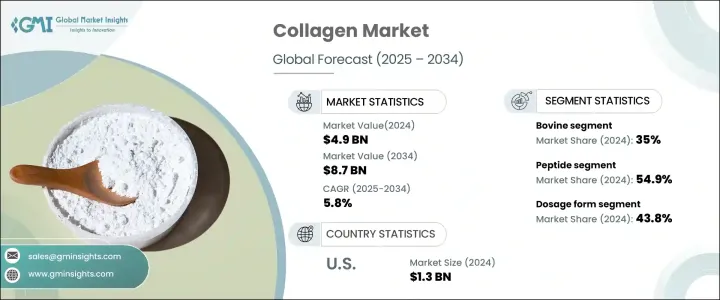
|
시장보고서
상품코드
1698545
콜라겐 시장 기회, 성장 촉진 요인, 산업 동향 분석, 예측(2025-2034년)Collagen Market Opportunity, Growth Drivers, Industry Trend Analysis, and Forecast 2025-2034 |
||||||
세계의 콜라겐 시장은 2024년에 49억 달러로 평가되었으며, 2025년부터 2034년에 걸쳐 CAGR 5.8%로 성장할 것으로 예측되고 있습니다.
시장 성장의 원동력은 콜라겐을 주성분으로 하는 보충제에 대한 수요 증가와 식음료에 대한 배합 증가입니다. 분말, 알약, 그리고 기능성 식품으로 제공되는 콜라겐 보충제는 높은 흡수율로 인해 인기를 얻고 있습니다. 인간의 체내에서는 피부, 뼈, 관절, 근육에 필수적인 단백질인 콜라겐이 생성되지만, 그 생성량은 노화와 함께 감소하고 주름이나 관절의 불편함과 같은 문제로 이어집니다.

콜라겐을 보급하면 피부의 보습성과 탄력성이 향상되어 눈에 보이는 노화의 징후가 완화되는 것을 알 수 있습니다. 소비자들은 점점 더 개인 건강, 외모, 예방 관리에 집중하고 있으며, 이는 시장을 더욱 부추기고 있습니다. 또한, 콜라겐은 다양한 제품의 식감, 탄력성, 안정성을 높이기 위해서 식음료 분야에서 널리 사용되고 있습니다.
| 시장 범위 | |
|---|---|
| 시작 연도 | 2024년 |
| 예측 연도 | 2025-2034년 |
| 시작 금액 | 49억 달러 |
| 예측 금액 | 87억 달러 |
| CAGR | 5.8% |
2024년 콜라겐 시장은 제품별로 젤라틴과 펩티드로 구분되었습니다. 한 입자로 분해되어 피부, 장, 관절의 건강과 관련된 효능이 있기 때문에 영양보조식품에 널리 사용되고 있습니다.
콜라겐은 공급원에 따라 소, 돼지, 해양 및 기타 범주로 분류됩니다. 소 부문은 풍부한 가용성과 관절염 완화, 뼈 건강 및 피부 개선과 같은 관련 건강상의 이점으로 인해 2024년 35%의 점유율로 시장을 선도했습니다. 피부의 탄력성과 보습에 필수적인 I형 및 Ⅲ형 콜라겐 생산을 지원합니다.
제형별로는 2024년 시장은 콜라겐 파우더가 43.8%의 점유율을 차지했습니다. 콜라겐 파우더나 쉐이크는 액체에 녹기 쉽고, 유연한 섭취가 가능하기 때문에 제조업체는 적극적으로 홍보하고 있습니다.
용도별로 시장은 식품, 헬스케어, 영양보조식품, 퍼스널케어 및 화장품 등으로 구분됩니다. 영양 보충제 부문은 시장의 41%를 차지하며 콜라겐이 피부 건강, 세포 재생 및 구조적 무결성을 지원하는 역할을 하는 것이 그 원동력이 되고 있습니다. 콜라겐은 피부의 외관을 향상시키고, 장기의 보호를 유지하며, 탄력성을 개선하는 능력이 있기 때문에 보충제에 널리 사용됩니다.
미국 콜라겐 시장은 2024년 13억 달러로 평가되었으며 앞으로 수년간 안정적인 성장이 예상됩니다. 2021년 미국에서는 콜라겐이 90.4톤 소비되어 원료로서 최대 시장 규모를 차지해 타국을 압도했습니다. 미국의 수요 증가는 고령화에 기인하고 있으며, 2022년에는 65세 이상의 인구가 5,780만명으로 총 인구의 17.3%를 차지했습니다. 노인 인구가 증가함에 따라, 의료 용도 및 관절 건강에 대한 콜라겐 수요는 예측 기간 동안에도 여전히 강세를 보일 것으로 예상됩니다.
목차
제1장 조사 방법과 조사 범위
- 시장 범위와 정의
- 기본 추정과 계산
- 예측 계산
- 데이터 소스
제2장 주요 요약
제3장 업계 인사이트
- 생태계 분석
- 밸류체인에 영향을 주는 요인
- 이익률 분석
- 혁신
- 장래의 전망
- 제조업체
- 유통업체
- 공급자의 상황
- 이익률 분석
- 주요 뉴스
- 규제 상황
- 영향요인
- 성장 촉진요인
- 헬스케어 분야의 성장
- 식음료 수요 증가
- 퍼스널케어 분야의 급성장
- 업계의 잠재적 위험 및 과제
- 동물 학대에 대한 엄격한 규칙
- 성장 촉진요인
- 성장 가능성 분석
- Porter's Five Forces 분석
- PESTEL 분석
제4장 경쟁 구도
- 소개
- 기업 점유율 분석
- 경쟁 포지셔닝 매트릭스
- 전략 전망 매트릭스
제5장 시장 규모와 예측 : 제품별, 2021년-2034년
- 주요 동향
- 젤라틴
- 펩티드
제6장 시장 규모와 예측 : 공급원별, 2021년-2034년
- 주요 동향
- 소
- 돼지
- 해양
- 기타
제7장 시장 규모와 예측 : 투여형태별, 2021년-2034년
- 주요 동향
- 분말
- 액체
- 캡슐제
- 기타
제8장 시장 규모와 예측 : 용도별, 2021년-2034년
- 주요 동향
- 식품
- 스낵 & 시리얼
- 유제품
- 베이커리 및 과자류
- 기타
- 헬스케어
- 정형외과
- 치과
- 상처 케어
- 기타
- 영양보조식품
- 영양보조식품
- 기능성 식품
- 기타
- 퍼스널케어&화장품
- 스킨케어
- 헤어 케어
- 기타
제9장 시장 규모와 예측 : 지역별, 2021-2034년
- 주요 동향
- 북미
- 미국
- 캐나다
- 유럽
- 영국
- 독일
- 프랑스
- 이탈리아
- 스페인
- 러시아
- 아시아태평양
- 중국
- 인도
- 일본
- 한국
- 호주
- 라틴아메리카
- 브라질
- 멕시코
- 아르헨티나
- 중동 및 아프리카
- 남아프리카
- 사우디아라비아
- 아랍에미리트(UAE)
제10장 기업 프로파일
- Glanbia Performance Nutrition
- Evonik
- Kenvue
- Nitta Gelatin
- Gelita
- Weishardt Group
- Rousselot
- GNC
- Tessenderlo Group
The Global Collagen Market was valued at USD 4.9 billion in 2024 and is projected to expand at a 5.8% CAGR from 2025 to 2034. Market growth is driven by increasing demand for collagen-based supplements and their rising incorporation in food and beverages. Collagen supplements, available in powders, pills, and functional foods, are gaining popularity due to their high absorption rates. The human body produces collagen, a vital protein for skin, bones, joints, and muscles, but its production declines with age, leading to issues like wrinkles and joint discomfort.

Supplementing with collagen has been found to improve skin hydration and elasticity, reducing visible signs of aging. With the global aging population rising, demand for health and wellness supplements, including collagen, is expected to grow significantly. Consumers are increasingly focused on personal health, appearance, and preventive care, further fueling the market. Additionally, collagen is widely used in the food and beverage sector to enhance texture, elasticity, and stability in various products. However, challenges remain, particularly regarding the taste and aroma of marine collagen, which require masking techniques when used in formulations.
| Market Scope | |
|---|---|
| Start Year | 2024 |
| Forecast Year | 2025-2034 |
| Start Value | $4.9 Billion |
| Forecast Value | $8.7 Billion |
| CAGR | 5.8% |
In 2024, the collagen market was segmented by product into gelatin and peptides. The peptide segment accounted for 54.9% of the total market due to its superior absorption and digestion. Peptide collagen, which undergoes extensive hydrolysis to break down into smaller particles, is widely used in dietary supplements for benefits related to skin, gut, and joint health. Gelatin, which is only partially hydrolyzed, is primarily utilized in food products like desserts and jellies to provide texture and structure.
Based on sources, collagen is classified into bovine, porcine, marine, and other categories. The bovine segment led the market with a 35% share in 2024, attributed to its abundant availability and associated health benefits, including arthritis relief, bone health, and skin improvement. Bovine collagen supports type I and III collagen production, essential for skin elasticity and moisture retention. Porcine collagen, growing at a 5.9% CAGR, ranks as the second-largest source due to its affordability and compatibility with human biology. It is widely used in cosmetics, food, and biomedical applications.
In terms of dosage form, the market was dominated by collagen powder in 2024, holding a 43.8% share. Manufacturers are actively promoting collagen powders and shakes, as they easily dissolve in liquids and allow flexible consumption. These powders can also be customized based on personal preferences, making them a preferred choice among consumers.
By application, the market is segmented into food, healthcare, nutraceuticals, personal care and cosmetics, and others. The nutraceutical segment accounted for 41% of the market, driven by collagen's role in supporting skin health, cell regeneration, and structural integrity. Collagen is widely used in supplements due to its ability to enhance skin appearance, maintain organ protection, and improve elasticity.
The U.S. collagen market was valued at USD 1.3 billion in 2024 and is expected to grow steadily in the coming years. In 2021, collagen held the largest market size as an ingredient in the U.S., with 90.4 tons consumed, surpassing all other countries. The country's high demand stems from its aging population, with 57.8 million people aged 65 or older in 2022, making up 17.3% of the total population. With the elderly population increasing, collagen demand in medical applications and joint health is anticipated to remain strong in the forecast period.
Table of Contents
Chapter 1 Methodology & Scope
- 1.1 Market scope & definition
- 1.2 Base estimates & calculations
- 1.3 Forecast calculation
- 1.4 Data sources
- 1.4.1 Primary
- 1.4.2 Secondary
- 1.4.2.1 Paid sources
- 1.4.2.2 Public sources
Chapter 2 Executive Summary
- 2.1 Industry synopsis, 2021-2034
Chapter 3 Industry Insights
- 3.1 Industry ecosystem analysis
- 3.1.1 Factor affecting the value chain
- 3.1.2 Profit margin analysis
- 3.1.3 Disruptions
- 3.1.4 Future outlook
- 3.1.5 Manufacturers
- 3.1.6 Distributors
- 3.2 Supplier landscape
- 3.3 Profit margin analysis
- 3.4 Key news & initiatives
- 3.5 Regulatory landscape
- 3.6 Impact forces
- 3.6.1 Growth drivers
- 3.6.1.1 Rising healthcare sector
- 3.6.1.2 Growing food and beverage demand
- 3.6.1.3 Burgeoning personal care sector
- 3.6.2 Industry pitfalls & challenges
- 3.6.2.1 Stringent rules for animal abuse
- 3.6.1 Growth drivers
- 3.7 Growth potential analysis
- 3.8 Porter's analysis
- 3.9 PESTEL analysis
Chapter 4 Competitive Landscape, 2024
- 4.1 Introduction
- 4.2 Company market share analysis
- 4.3 Competitive positioning matrix
- 4.4 Strategic outlook matrix
Chapter 5 Market Size and Forecast, By Product, 2021-2034 (USD Billion) (Kilo Tons)
- 5.1 Key trends
- 5.2 Gelatin
- 5.3 Peptides
Chapter 6 Market Size and Forecast, By Source, 2021-2034 (USD Billion) (Kilo Tons)
- 6.1 Key trends
- 6.2 Bovine
- 6.3 Porcine
- 6.4 Marine
- 6.5 Others
Chapter 7 Market Size and Forecast, By Dosage Form, 2021-2034 (USD Billion) (Kilo Tons)
- 7.1 Key trends
- 7.2 Powder
- 7.3 Liquid
- 7.4 Capsule
- 7.5 Others
Chapter 8 Market Size and Forecast, By Application, 2021-2034 (USD Billion) (Kilo Tons)
- 8.1 Key trends
- 8.2 Food
- 8.2.1 Snacks & cereals
- 8.2.2 Dairy products
- 8.2.3 Bakery & confectionery products
- 8.2.4 Others
- 8.3 Healthcare
- 8.3.1 Orthopedic
- 8.3.2 Dental
- 8.3.3 Wound care
- 8.3.4 Others
- 8.4 Nutraceuticals
- 8.4.1 Dietary supplements
- 8.4.2 Functional food
- 8.4.3 Others
- 8.5 Personal care & cosmetics
- 8.5.1 Skin care
- 8.5.2 Hair care
- 8.5.3 Others
Chapter 9 Market Size and Forecast, By Region, 2021-2034 (USD Billion) (Kilo Tons)
- 9.1 Key trends
- 9.2 North America
- 9.2.1 U.S.
- 9.2.2 Canada
- 9.3 Europe
- 9.3.1 UK
- 9.3.2 Germany
- 9.3.3 France
- 9.3.4 Italy
- 9.3.5 Spain
- 9.3.6 Russia
- 9.4 Asia Pacific
- 9.4.1 China
- 9.4.2 India
- 9.4.3 Japan
- 9.4.4 South Korea
- 9.4.5 Australia
- 9.5 Latin America
- 9.5.1 Brazil
- 9.5.2 Mexico
- 9.5.3 Argentina
- 9.6 MEA
- 9.6.1 South Africa
- 9.6.2 Saudi Arabia
- 9.6.3 UAE
Chapter 10 Company Profiles
- 10.1 Glanbia Performance Nutrition
- 10.2 Evonik
- 10.3 Kenvue
- 10.4 Nitta Gelatin
- 10.5 Gelita
- 10.6 Weishardt Group
- 10.7 Rousselot
- 10.8 GNC
- 10.9 Tessenderlo Group



















